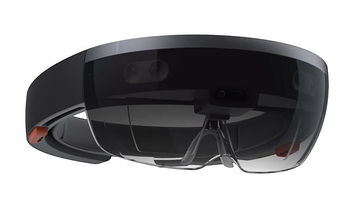Difference between revisions of "Microsoft HoloLens"
Xinreality (talk | contribs) |
Xinreality (talk | contribs) |
||
| Line 35: | Line 35: | ||
|Website=[http://www.microsoft.com/microsoft-hololens/en-us Microsoft HoloLens] | |Website=[http://www.microsoft.com/microsoft-hololens/en-us Microsoft HoloLens] | ||
}} | }} | ||
| − | Microsoft HoloLens is a [[Augmented Reality]] [[device]] developed by [[Microsoft]]. It is part of the [[Windows Holographic]] [[AR Platform]] incoporated wtih [[Windows 10]] OS. Similar to other [[OHMD]]s, HoloLens is a see through display worn over your eyes. Unlike [[Oculus Rift]] and [[Virtual Reality#Devices|VR Devices]], the eye-piece component of HoloLens is transparent and the headset requires neither | + | Microsoft HoloLens is a [[Augmented Reality]] [[device]] developed by [[Microsoft]]. It is part of the [[Windows Holographic]] [[AR Platform]] incoporated wtih [[Windows 10]] OS. Similar to other [[OHMD]]s, HoloLens is a see through display worn over your eyes. Unlike [[Oculus Rift]] and [[Virtual Reality#Devices|VR Devices]], the eye-piece component of HoloLens is transparent and the headset requires neither PC nor smartphone. It is able to project virtual content over real world objects. One of the example Microsoft used was Windows-like interfaces were projected onto walls and furniture. Users can interact with these projections with gestures and voice commands. |
Microsoft HoloLens runs a self-contained Windows 10 computer. It features HD 3D optical head-mounted display, spatial sound projection and advanced sensors to allow its users to interact its AR applications through head movements, gestures and voices. | Microsoft HoloLens runs a self-contained Windows 10 computer. It features HD 3D optical head-mounted display, spatial sound projection and advanced sensors to allow its users to interact its AR applications through head movements, gestures and voices. | ||
| Line 42: | Line 42: | ||
==Hardware== | ==Hardware== | ||
| − | The smartglass head-mounted display requires neither cords nor phones | + | The smartglass head-mounted display requires neither cords nor phones. It features a HD 3D [[optical head-mounted display]], spatial sound system along with various sensors. |
Sensors include head tracking, sound capture and an energy efficient depth camera with 120°×120° field of view. | Sensors include head tracking, sound capture and an energy efficient depth camera with 120°×120° field of view. | ||
Revision as of 00:57, 1 May 2015
| Microsoft HoloLens | |
|---|---|

| |
| Basic Info | |
| Type | Augmented Reality |
| Subtype | Optical head-mounted display |
| Developer | Microsoft |
| Manufacturer | Microsoft |
| Website | Microsoft HoloLens |
| System | |
| Operating System | Windows 10 |
| CPU | Intel Cherry Trail Atom |
| Storage | |
| Display | |
| Image | |
| Optics | |
| Tracking | |
| Rotational Tracking | IMUs |
| Positional Tracking | Depth Camera with 120°×120° FOV |
| Audio | |
| Audio | Spatial Sound |
| Connectivity | |
| Device | |
Microsoft HoloLens is a Augmented Reality device developed by Microsoft. It is part of the Windows Holographic AR Platform incoporated wtih Windows 10 OS. Similar to other OHMDs, HoloLens is a see through display worn over your eyes. Unlike Oculus Rift and VR Devices, the eye-piece component of HoloLens is transparent and the headset requires neither PC nor smartphone. It is able to project virtual content over real world objects. One of the example Microsoft used was Windows-like interfaces were projected onto walls and furniture. Users can interact with these projections with gestures and voice commands.
Microsoft HoloLens runs a self-contained Windows 10 computer. It features HD 3D optical head-mounted display, spatial sound projection and advanced sensors to allow its users to interact its AR applications through head movements, gestures and voices.
HoloLens was announced in Windows 10 Event on January 21st, 2015.
Contents
Hardware
The smartglass head-mounted display requires neither cords nor phones. It features a HD 3D optical head-mounted display, spatial sound system along with various sensors.
Sensors include head tracking, sound capture and an energy efficient depth camera with 120°×120° field of view.
For processors, in addition to CPU and GPU, HoloLens will possess an HPU, holographic processing unit. HPU is a coprocessor that is dedicated to integrating real world and virtually generated content. It consolidates data and information from various sensors and digitally generated information and graphics.
Apps
HoloLens can project various Windows 10 Apps, programs and browsers onto walls and other objects.
Windows Holographic is Microsoft's AR platform incorporated in Windows 10 OS. Windows Holographic API is implemented in all devices running Windows 10 including smartphones and tablets.
Holo Studio allows the user to create 3D models used for 3D Printing. In addition to gesture commands it allow accepts voice commands.
HoloBuilder is a Augmented Reality version of Minecraft.
Developer
History
January 21, 2015 - Microsoft HoloLens was officially announced.
April 28, 2015 - First live stage presentation of the HoloLens.